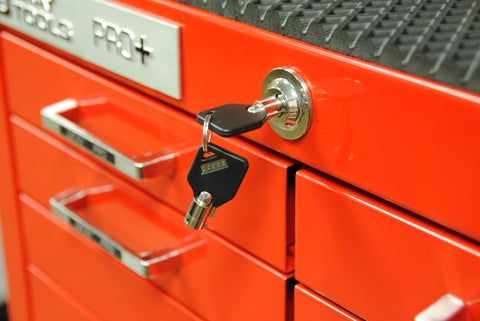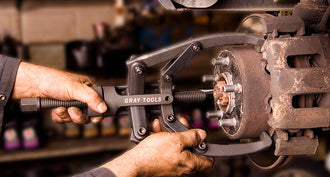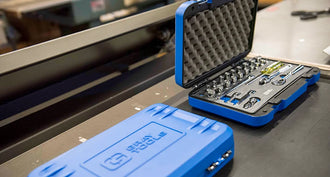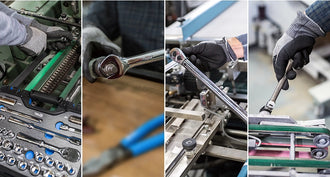Shopping For a New Tool Chest? Here Is What You Need To Know (Part 3: Casters and Locking Mechanism)
- Gray Tools Official Blog
- 09 Aug, 2017
In part 2 of our series on how to choose your next toolbox, we focused on the drawer system. We specifically explored drawer design and slide types.
In our final instalment, we will turn our attention to casters and the locking mechanism. With that in mind, let us begin.
Although entire full-length articles can be written solely about casters, we are going to focus only on the key essentials.
Basic Caster Anatomy & Terminology

Below is a list of common terms used when referencing casters.
- Durometer – An industry scale for measuring a wheel's hardness. The higher the number the harder the wheel.
- Rollability - the ease of beginning and maintaining rolling motion. Rollability on a toolbox will be influenced by many factors such as: wheel durometer, floor conditions, quality of bearings in the wheel and weight of the toolbox.
- Maximum Load Capacity - the maximum load a caster can hold.
- Overall Height - The vertical distance from the floor to the top of the top plate or in the case of a roller cabinet the bottom of the toolbox.
- Top Plate – connected to the fork, the plate mates with the toolbox and features the boltholes through which the mounting screws will be inserted. A larger top plate can positively contribute to the toolboxes' overall stability.
- Tread Width - width of the caster wheel.
- Wheel Diameter - the distance of the wheel measured vertically from one side of the tread to the other.
- Side Brake – a lever locking mechanism found on the side of the caster, which prevents caster rolling. Typically requires a foot activated engagement.
- Top Brake – a tab-like locking mechanism found on the top wheel, which prevents caster rolling and swivelling. Typically requires a foot activated engagement and is often referred to as a 360° , easier to engage than a side brake.
Understanding the Work Environment
Many of the features, benefits, and considerations below must be individually evaluated and determined based on specific workplace environment and conditions.

Frequency of Movement
• If the roller cabinet isn't going to move often or ever the most important feature is likely going to be wheel hardness. In this case the harder the better.
• Soft-wheeled casters are to be avoided if a toolbox isn't going to be moved. Soft casters that aren’t rolled regularly can "dent", creating a flat tire or flat bottom that will prevent future rolling.
Floor Surface Being Rolled Across
• If the cabinet is going to be moved it is important to know the surface conditions.
Smooth polished floors such as those found in hospitals are ideally suited to soft wheeled pneumatic or rubber wheels. Soft wheeled casters will effortlessly glide across smooth surfaces, with minimal noise, floor marring, and effort required.
Uneven, chemically soiled, and dirty floors like those found in industrial environments are ideally suited to hard polyurethane or phenolic wheeled casters. Hard casters resist chemical solvents, more easily roll over obstructions and better resist floor debris such as shavings and fillings.
Weight Capacity
• Casters, like drawer slides, are rated by weight capacity. The greater the stated capacity the larger the load the casters can hold and move. It is pointless to purchase a heavy-duty toolbox capable of holding hundreds or thousands of pounds if the casters cannot match the load limit.
It is important to understand that there is no "perfect caster" for all work environments.
The softer the caster the smoother and quieter it will roll. Unfortunately, the softer the caster the easier it will be damaged in harsh workplaces and the lower the maximum weight capacity will be.
Therefore, when conducting research on your next toolbox, try to answer these questions as best you can:
- What is the floor surface you will be placing and moving your roller cabinet on?
- How often will you move the roller cabinet?
- How much weight will your toolbox be storing?
- How wide a toolbox are you going to need? Generally 4 casters is sufficient, however on toolboxes wider than 42" 6 casters are highly recommended for easier rolling and distribution of the larger load.
A final consideration; casters are the easiest to upgrade of all the toolbox components.
If, in time, you feel the standard casters do not meet your needs, you can always replace them with aftermarket versions that will.
Toolbox Locking Mechanism
The final component we will examine is the locking mechanism. While locking a toolbox seems like an obvious function, it can actually have a dramatic influence on workplace safety.
With health and safety on the minds of employees and management like never before, it is not surprising to find advanced safety innovations into today's modern toolboxes.
Below are examples of two such technologies:
One-Drawer Opening System
Toolboxes equipped with one drawer opening systems prevent users from opening more than a single drawer at any given time.
By allowing a maximum of one drawer to open users are prevented from creating employee workflow restrictions and important accidental tip-overs.
Tip-overs occur when too much of the toolboxes' weight is moved beyond its centre of gravity. This usually happens when too many heavily filled drawers are fully or partially opened at once.
Safety Latch Opening System
Safety latch-equipped toolboxes are fitted with a hidden latch located below the drawer handle.
To activate or disengage the latch users must tilt the drawer handle upwards or release a lever. The required lifting or pressing motion prevents already shut drawers from accidentally opening.
This feature is indispensable for users who move their toolboxes frequently throughout the day. Users typically close the drawers but often forget to lock their toolboxes before moving them.
Safety latch systems prevent the unexpected opening of multiple unlocked drawers during travel. Once a heavily loaded toolbox begins tipping there is no stopping it. A tipped heavily loaded toolbox can lead to serious personal injury.
Another important function for the locking mechanism is theft deterrence.
Although no lock is entirely safe from would be thieves some locks create a greater deterrence than others. Examples of such locks include those requiring access cards, fingerprint ID's and multi-digit keypad passwords.
Unfortunately, due to cost, the most common locks seen today are tumbler and tubular style systems.
Before purchasing any toolbox be sure to ask the manufacturer about the availability of spare keys in the future (trust us they are going to get lost at some point) and the number of key lock combinations available. The greater the number of combinations the less likely coworkers will have a key capable of opening your toolbox.
Final Considerations
When deciding on a toolbox model consider added accessories you might need, such as drawer liners, drawer guards, protective covers, and top mats.
Color, finish and design are a matter of personal preference, and unbelievably a major contributor to your overall satisfaction with your purchase.
Choose a color that will make your tool chest fit in the surrounding workspace and be sure the drawers are laid out in a way that reflects your needs and work habits.
Finally, the ability to service your toolbox and purchase spare parts should weigh in your selection. Reputable tool brands will be able to service your product on site should the need arise, and provide spare parts for years to come.





Very interesting and useful, thank’s for posting! Are your toolbox still made in Canada?